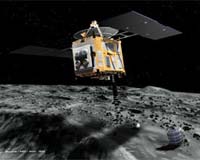 |
Pasadena CA (SPX) Nov 16, 2009 NASA's Dawn spacecraft re-entered our solar system's asteroid belt on Nov. 13, and this time it will stay there. Dawn first entered the belt (whose lower boundary may be defined as the greatest distance Mars gets from the sun (249,230,000 kilometers, or 154,864,000 miles) in June 2008. It remained within the belt for 40 days before its carefully planned orbital path brought it below the asteroid belt's lower boundary. This time around, Dawn's flight path will remain above this hypothetical lower boundary for the rest of the mission and for the foreseeable future - Dawn will become the first human-made object to take up permanent residence in the asteroid belt. The mission of the 1,098-kilogram (2,421-pound) Dawn spacecraft is to reconnoiter Vesta and Ceres, the asteroid belt's two most massive inhabitants -- the asteroid Vesta and dwarf planet Ceres. The goal of this eight-year, 4.9-billion-kilometer (3-billion-mile) mission is to answer basic questions about the formation of planets in our solar system. NASA's unmanned Dawn spacecraft will be the first ever to orbit two planetary bodies on a single voyage. Dawn is 619 days away from arrival at its first celestial objective, asteroid Vesta. Share This Article With Planet Earth
Related Links Dawn Asteroid and Comet Mission News, Science and Technology
 Asteroid Explorer "HAYABUSA" Ion Engine Anomaly
Asteroid Explorer "HAYABUSA" Ion Engine AnomalyTokyo, Japan (SPX) Nov 12, 2009 On November 4th (Wed., Japan Standard Time), the Japan Aerospace Exploration Agency identified that one of the main ion engines (Thruster D) aboard the Asteroid Explorer "HAYABUSA" had autonomously stopped detecting a high neutralizer voltage owing to degradation. The HAYABUSA was in the second propulsion period during its return cruise back to the Earth in June 2010. Since the anomaly was ... read more |
|
| The content herein, unless otherwise known to be public domain, are Copyright 1995-2009 - SpaceDaily. AFP and UPI Wire Stories are copyright Agence France-Presse and United Press International. ESA Portal Reports are copyright European Space Agency. All NASA sourced material is public domain. Additional copyrights may apply in whole or part to other bona fide parties. Advertising does not imply endorsement,agreement or approval of any opinions, statements or information provided by SpaceDaily on any Web page published or hosted by SpaceDaily. Privacy Statement |